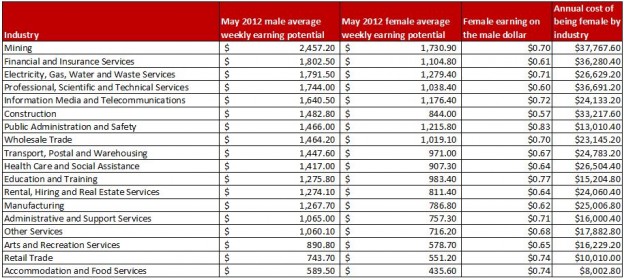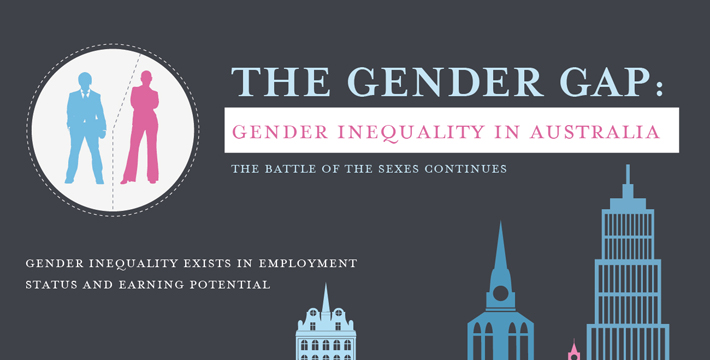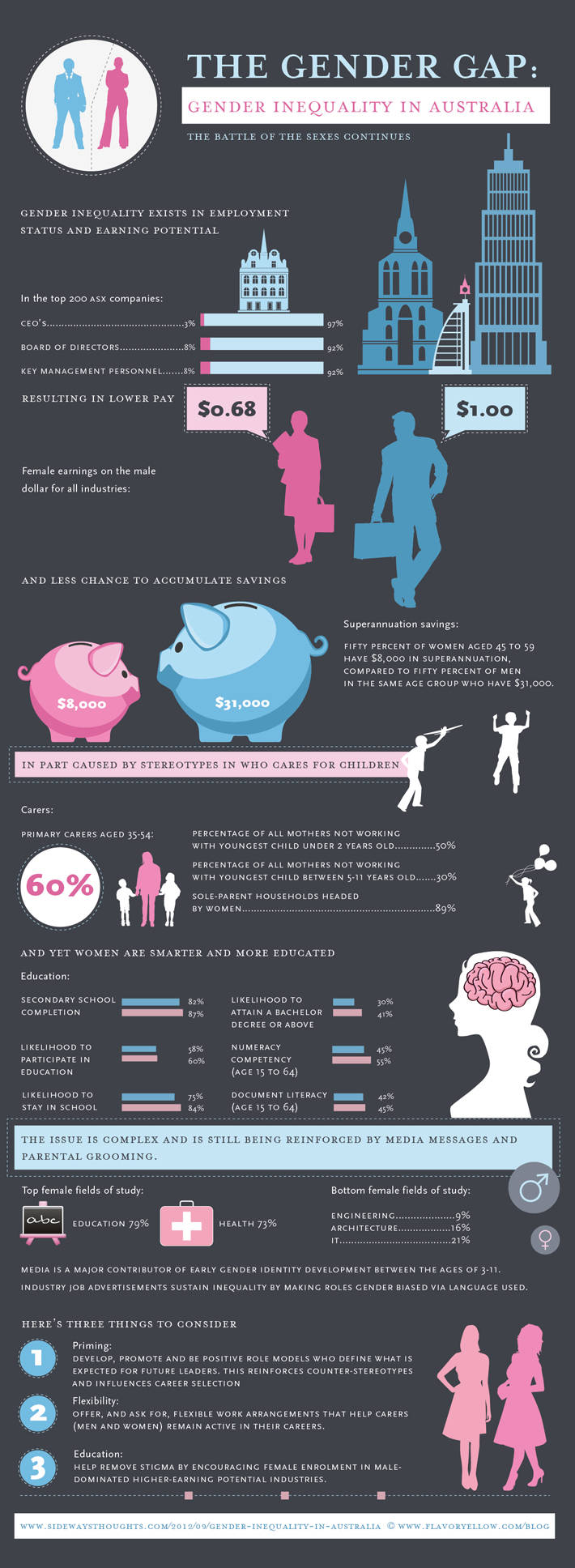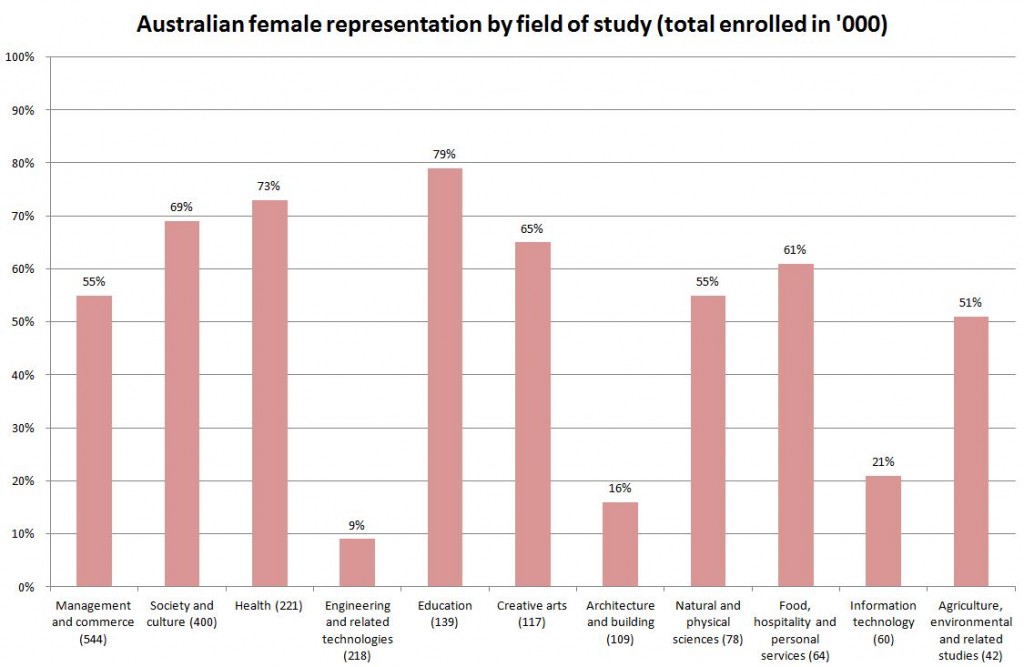Gender inequality in Australia: It’s alive and well, mate
Many thanks to the amazingly talented Theresa for converting my research project into an incredible infograph.
As a man, I feel slightly awkward talking about Australian gender inequality. Awkward as in a sense of shame of being the one not disadvantaged, exposed in my own culturally adopted subtle bias, and questioning whether I am betraying my own gender. My awkwardness quickly dissolves, however, when I consider the world I am preparing for my daughter and generations to follow.
I would not consider myself a male feminist, but once I became aware of the situation, I wonder how we got to this point and what can be done to change the situation.
The leadership gap
What do you think of when you hear “gender inequality”? Up until my recent research project, I thought of developing countries that discriminated against women who did not have protection of our modern Australian policy protection measures. That is when I gave the topic any consideration at all, trusting the issue was being addressed with Australia’s $US800 million contribution – 30 percent of its total OECD investment – towards supporting gender equality and women’s empowerment in developing countries.
I then stumbled across the Australian Bureau of Statistics Gender Indicators and had a hard time reconciling the numbers as they applied to my own country. Females represent only three percent of CEOs, 8.4 percent of board directors and eight percent of executive key management personnel of the top 200 ASX companies.
There surely must be a logical reason for this in our politically correct age of affirmative action. Is it because there are not that many women working? On the contrary, 45.3 percent of the total workforce is female. There are fewer females working, but not enough to explain the massive leadership gap.
What we are seeing is a gender discrepancy between general participation and leadership. In Tasmania for example, women make up 70 percent of the education sector but hold 37 percent of management positions. The lack of females attaining leadership roles explains in part the gender wage gap.
The wage gap – industry and academic specialisation

The ABS data above shows women on average across all industries earn $0.68 on the male dollar. This decreases to $0.66 for all industries that have a greater population of males and increases to $0.71 for the average of all industries that have more females.
Not only are females not represented in leadership roles, they are also not equally positioned to take advantage of higher-income industries. Of the top nine industries by wage potential, all but two have more males than females. It could be said then that industrialised societies place less value on that which is considered “feminine” than that which is considered to be “masculine”.
This is not looking to change anytime soon when considering candidates coming from academic institutions. Fields such as education and health are predominantly female, while engineering, architecture and IT are male. Looking at who is taking what courses at school would infer that girls teach and heal while boys build.
And yet women are generally more educated than men. Women completing secondary school has increased significantly from 15 percent in 1967 to current rates of 87 percent and exceeds male completion rates of 82 percent. Women are more likely to pursue further education and score higher in numeracy and reading comprehension scores.
By the numbers, women are more educated and smarter, but earn less and have less success in obtaining leadership positions. With these factors in mind, increased female education rates can be seen as a tax on a gender struggling to compete on an uneven playing field.
Carers and ability to be financially secure
A large contributing factor to the discrepancy is the propensity for women to not participate in the workforce during prime career years. Of the total population of females aged 20 to 74 years, 65.3 percent participate in the workforce as compared to 79.7 percent of males. This is due to females taking the role of caring for children and the elderly. Around 60 percent of primary carers aged 35 to 54 are female.
Half of all mothers whose youngest child is under two years old and almost a third of mothers whose youngest child is between five and 11 are not employed in the workforce. In 2008, 88.5 percent of sole-parent households were headed by a female. Women earn less but are over eight times more likely to take responsibility in a single-parent situation.
The lack of earning potential during the prime working years impacts on the ability to establish long-term financial stability and secure housing. Fifty percent of women aged 45 to 59 have $8,000 or less in their superannuation funds compared to $31,000 for men. Given equal incomes, women are more likely to purchase a home than men but more females at lower pay and lower workforce participation mean women are less likely to enter the housing market. Similar to education, the greater propensity for females to secure housing can be seen as a need to establish a security that men may not feel necessary.
The data points to the fact that women have to be more resilient and work harder to achieve equality in leadership and subsequent pay levels. It is not surprising then that women CEO’s are more likely to have experienced childhood upheaval to engrain that resiliency. Their male counterparts by comparison often come from backgrounds of a nurturing family unit with a stay-at-home mom and were usually captains for their football teams.
Policy and media: It hasn’t been that long but it will likely take a lot longer
I suppose I could forgive the discrepancy based on the relative recency of Australian gender equality policies. Notable events include:
- the 1966 elimination of the bar on married women being employed in the Commonwealth public service,
- the 1975 introduction of no-fault divorce,
- the 1984 passing of the Commonwealth Sex Discrimination Act, and
- the 1986 Commonwealth Affirmative Action (Equal Employment Opportunity for Women Act).
Policy alone, however, could be said to simply “encourage” companies to provide equal opportunity with little punitive action. Even with policy, segregation can be defined by career pathways that require long hours and job rotation involving travel that limits female participation due to traditional carer status. Women can also continue to be disadvantaged in an industry when their industry identity does not “fit” with gendered stereotypes. These factors result in a situation where equal access and equal treatment are not sufficient for equal outcomes.
Popular media perpetuates gender stereotypes, contributing to norms about gender and individual’s belief, or doubt, in themselves. This influence starts early, with media being a main contributor to gender identity development between the ages of 3- 11. This early gender identity is then a predictor in defining long-term career paths. These career paths are reinforced through subtle reinforcement of gender bias. For example, job advertisements sustain inequality by making roles more or less attractive to a preferred gender through the language used in the advertisements.
Other reflections of bias are not so subtle such as when industry leaders compare Prime Minister Julia Gillard to an old cow. Males have a good thing going and I expect it will take decades more to change generational belief patterns. We will continue to experience inequality so long as it is acceptable for male CEOs to refer to women as “chicks” around boardroom tables (regardless whether they use the term themselves) or tradesmen to express their frustration at my wife by deriding her views as “just like a woman”.
Three strategies to address inequality
The problem is complex and engrained into the fabric of our culture. I do not expect the situation to be addressed in my generation and I wonder at what unconscious bias I perpetuate myself. There are some intentional things we can do, however, to support change now and for generations to come.
- Priming
Gender stereotypes create self-fulfilling prophesies as male and female role models become successful in their gender-dominant occupations. This “priming” factor defines what is expected for future leaders, reinforces stereotypes and influences career selection. The priming factor is also critical in defining the individual’s self-efficacy, or belief in what they can achieve, and determines what a woman expects to get paid throughout her career. This underscores the value of role models that are contrary to industry trends such as the recent appointment of 37-year old Marissa Mayer as Yahoo! CEO.The opportunity is to develop, promote, and be the examples needed to counter existing stereotypes. This is the reason why organisations such as Chief Executive Women and Women in Technology exist, to encourage and case study women to both current professionals and upcoming generations in attempts to change societal norms. Organisation’s such as The CEO Institute are still only 15 percent female, but it is a statistic they are intentionally focusing on changing. - Industry education and awareness
Another challenge is removing gender stereotypes in high-revenue potential industries. The reason why we reward computer programmers more than teacher with significantly more experience and education is a problem for another day. We can, however, work to remove the gender stigma for higher pay-potential industries.The government acknowledges the opportunity. At the time of this blog post in 2012, the Queensland Government is offering a $5,000 per year scholarship for women pursuing continuing studies in male dominated fields. This can reduce a $9,000 per year post-graduate degree down to only $4,000 per year. The opportunity is to get the word out about these programs and encourage females to take up the programs to further their career. - Flexibility
It is all well and good to highlight statistics of women as carers, but there are some biological realities we have to accept if we are to continue to populate the Earth. There are opportunities to provide flexibility in roles to allow for the caring of families and continuation of careers. Typical options include part-time work, job sharing, telecommuting, compressed working hours, and flexible working hours. My current profession of IT in particular is prime for virtualisation of work in programming fields.
Gender inequality is alive and well in Australia. I don’t have the answers, but I can hope to not be part of the problem and contribute to a solution that, given the scale of the situation, I may not see in its fullness in my lifetime.




Well said as usual. Good thoughts on moving forward.
Has there been any studies done on “Marital Status” equality? I have seen in my experience that men who are married with a wife and children to support often get paid more than their single counterparts for the same roles.
Hi Greg,
Yes, many. You are referring to the “marriage premium” , where men who are married earn more than men who are not married. This could also be considered a “marriage penalty” for females. Like gender wage disparity, the phenomenon is complex and robust across variables. A few things known about it:
— It is more robust at lower salaries and can actually be negative at higher salaries: Who benefits from marriage?
— Some say the situation is a result of allowing males to specialise in a field and not do housework. Studies show this is not the case, with married and unmarried men performing similar levels of housework: Household specialization and the male marriage wage premium
— Another study spanning two decades in Norway looked at whether the premium was due to selection (men who are likely to get married are likely to get be the type of people to earn more), treatment (Once married, a man changes to become the type of person who gets paid more), or discrimination (employers pay more to married men). Outcome was that selection accounts for 80 percent of the premium. The male marital wage premium: Sorting vs. differential pay
Other factors touched on by research include wage increases associated with delays in family formation, impacts on when the first child is born, variations on self-employed salaries (minimal), and cultural influences.
Hope that answers your question!
Chad
Hey Chad,
Just checking out your blog.. Looking forward to catching up and talking more about this!
I am VERY passionate about this exact topic..
Tamsin
Thanks Tamsin. I look forward to hearing your thoughts!
Chad
Women usually have to undergo various levels of discrimination at work. It may be the 21st century, but women are still under this cloud that labels them as less capable than men.
With such a background it is surprising that a higher number of women have come to the forefront as high ranking officers in many industries nowadays. However, gender inequality still has a long way to go. Hopefully, our daughters would find a world better welcoming than ours.
https://goo.gl/HBvfqg